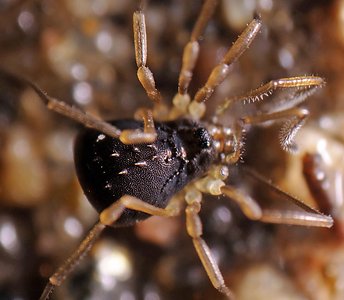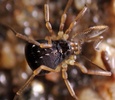Hesperonemastoma
Axel Schönhofer- Hesperonemastoma pallidimaculosum (Goodnight & Goodnight 1945) Gruber 1970
- Hesperonemastoma modestum (Banks 1894) Gruber 1970
- Hesperonemastoma packardi ((Roewer 1914) Gruber 1970
- Hesperonemastoma kepharti (Crosby & Bishop 1924) Gruber 1970
- Hesperonemastoma smilax Shear 2010
Introduction
The North American genus Hesperonemastoma shows strong morphological and ecological convergence with Nemastomatinae species in Europe, and had long been treated as such. Yet, defining characteristics of Ischyropsalidoidea are present, as well as the absence of clavate hairs and presence of bottlebrush hairs point to this superfamily. Herein it is easily defined by body form of nemastomatid habit, being globular, minute (1-2 mm) and often with rows of bridge-thorns, as well as exhibiting slender palps, moderate cheliceral size and short legs. Morphological peculiarities of the genus concern the chelicerae that lack glandular structures in males while such seem present on the femora of the palps in some species. The penis is short, often filled in its whole length by the single muscle and the penial glans is short and compact, set with strong spines and a short, often bent stylus (Gruber 1970). The distribution in North America is disjunct, with a continuous range along the western Coast from California to Canada, a second part in the Central to Northern Rocky Mountains and the third in the Appalachians. In the Southwest they are confined to higher altitudes.
Taxonomy and Discussion of Phylogenetic Relationships
Gruber (1970) established the genus and transferred it to Ischyropsalidoidea, studying limited material. He mentioned species borders drawn by his descriptions to not be definite. A revision is necessary to clarify species limits, as the outlined forms appear very heterogeneous. Genetic data supports Hesperonemastoma to be closely related to the apparently morphological distant genus Taracus (Giribet et al. 2010). Similarities can be seen in the absence of male cheliceral glands, the slender palps set with bottlebrush hairs and the genital morphology, which is relatively simple.
Ecology and Life History
Species of Hesperonemastoma are recorded from different forest communities where they can reach high abundances. They are mostly found under stones and logs but can also be sieved from leaf litter. Loose aggregations of up to 40 specimens have been found. One troglobiont species is known (Shear 2010).
References
Giribet, G., Vogt, L. Pérez-González, A., Sharma, P. and A. B. Kury. 2010. A multilocus approach to harvestman (Arachnida: Opiliones) phylogeny with emphasis on biogeography and the systematics of Laniatores. Cladistics 26:408-437.
Gruber, J. 1970. Die "Nemastoma"-Arten Nordamerikas (Ischyropsalididae, Opiliones, Arachnida). Annalen des Naturhistorischen Museums in Wien 74:129-144.
Shear, W. A. 2010. Hesperonemastoma smilax, n. sp., a remarkable new harvestman from a cave in West Virginia, with comments on other reported cave-dwelling Hesperonemastoma species (Opiliones, Ischyropsalidoidea, Sabaconidae). Journal of Cave and Karst Studies 72(2):105-110.
Title Illustrations

| Scientific Name | Hesperonemastoma sp |
|---|---|
| Specimen Condition | Live Specimen |
| Identified By | Axel Sch?nhofer |
| Life Cycle Stage | adult |
| Copyright |
© 2011 Axel Schönhofer

|
| Scientific Name | Hesperonemastoma modestum |
|---|---|
| Specimen Condition | Live Specimen |
| Identified By | Axel Sch?nhofer |
| Life Cycle Stage | adult |
| Copyright |
© 2011 Axel Schönhofer

|
About This Page
Many thanks to Angela DiDomenico for the final English check.
Axel Schönhofer

San Diego States University, San Diego, California, USA
Correspondence regarding this page should be directed to Axel Schönhofer at
Page copyright © 2012 Axel Schönhofer
 Page: Tree of Life
Hesperonemastoma .
Authored by
Axel Schönhofer .
The TEXT of this page is licensed under the
Creative Commons Attribution-NonCommercial License - Version 3.0. Note that images and other media
featured on this page are each governed by their own license, and they may or may not be available
for reuse. Click on an image or a media link to access the media data window, which provides the
relevant licensing information. For the general terms and conditions of ToL material reuse and
redistribution, please see the Tree of Life Copyright
Policies.
Page: Tree of Life
Hesperonemastoma .
Authored by
Axel Schönhofer .
The TEXT of this page is licensed under the
Creative Commons Attribution-NonCommercial License - Version 3.0. Note that images and other media
featured on this page are each governed by their own license, and they may or may not be available
for reuse. Click on an image or a media link to access the media data window, which provides the
relevant licensing information. For the general terms and conditions of ToL material reuse and
redistribution, please see the Tree of Life Copyright
Policies.
- First online 08 July 2012
- Content changed 08 July 2012
Citing this page:
Schönhofer , Axel. 2012. Hesperonemastoma . Version 08 July 2012 (under construction). http://tolweb.org/Hesperonemastoma/60686/2012.07.08 in The Tree of Life Web Project, http://tolweb.org/





4.300a.jpg)

4.100a.jpg)


 Go to quick links
Go to quick search
Go to navigation for this section of the ToL site
Go to detailed links for the ToL site
Go to quick links
Go to quick search
Go to navigation for this section of the ToL site
Go to detailed links for the ToL site